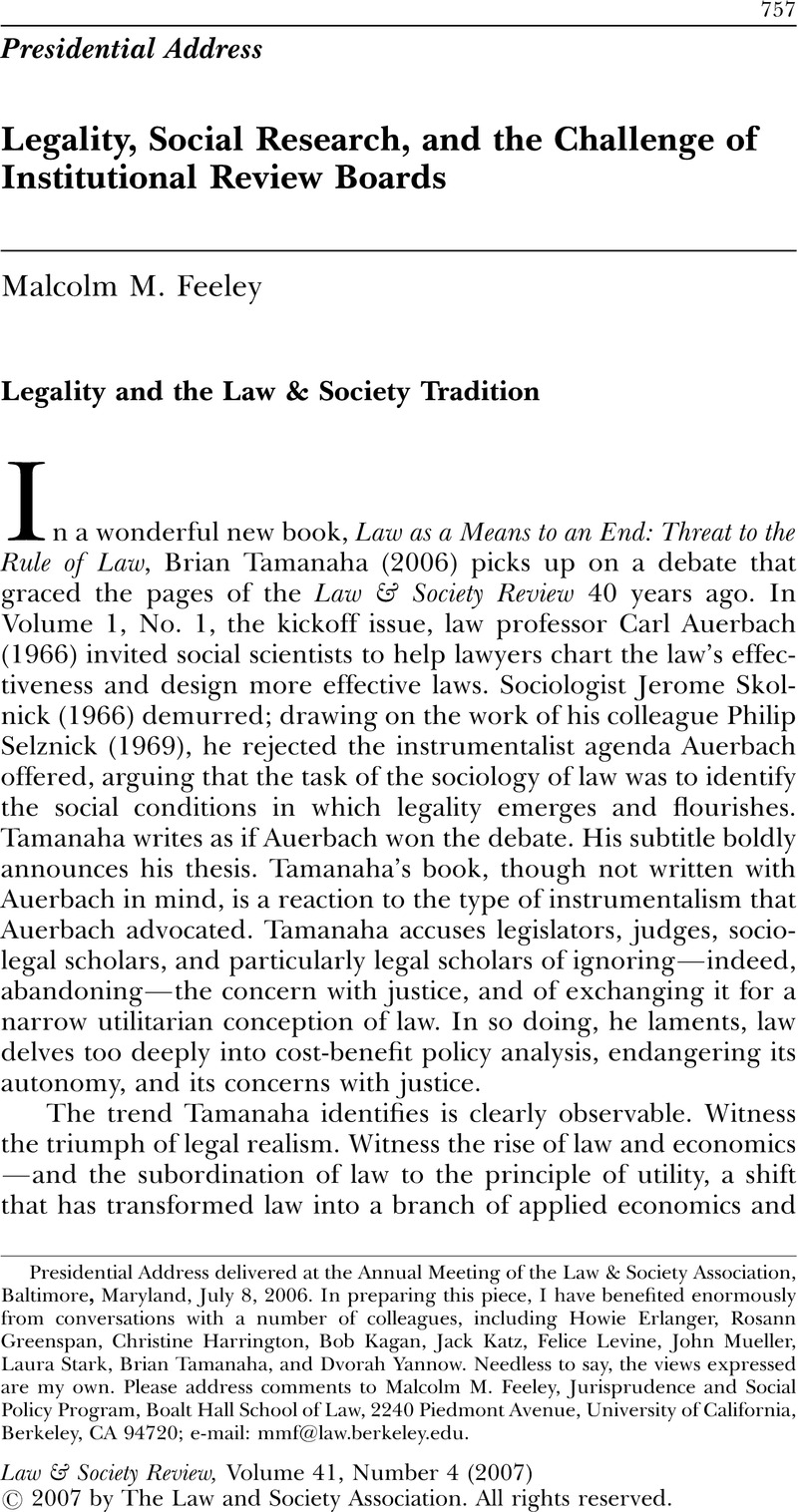Crossref Citations
This article has been cited by the following publications. This list is generated based on data provided by Crossref.
Katz, Jack
2007.
Toward a Natural History of Ethical Censorship.
Law & Society Review,
Vol. 41,
Issue. 4,
p.
797.
Savelsberg, Joachim J.
and
King, Ryan D.
2007.
Law and Collective Memory.
Annual Review of Law and Social Science,
Vol. 3,
Issue. 1,
p.
189.
Borenstein, Jason
2008.
The Expanding Purview: Institutional Review Boards and the Review of Human Subjects Research.
Accountability in Research,
Vol. 15,
Issue. 3,
p.
188.
Bonnet, François
and
Robert, Bénédicte
2009.
La régulation éthique de la recherche aux États-Unis : histoire, état des lieux et enjeux.
Genèses,
Vol. n° 75,
Issue. 2,
p.
87.
Holosko, Michael J.
Thyer, Bruce A.
and
Danner, J. Elaine Howse
2009.
Ethical Guidelines for Designing and Conducting Evaluations of Social Work Practice.
Journal of Evidence-Based Social Work,
Vol. 6,
Issue. 4,
p.
348.
Yanow, Dvora
2010.
Review Essay: Studying Organizations Ethnographically: Is ‘organizational’ ethnography distinctive? David Silverman: A Very Short, Fairly Interesting and Reasonably Cheap Book about Qualitative Research 2007, London: Sage Publications, 159 pages (pbk) Paul Atkinson, Amanda Coffey, Sara Delamont, John Lofland and Lyn Lofland (eds): Organizational Ethnography 2007, London: Sage Publications, 507 pages (pbk) Daniel Neyland: Handbook of Ethnography 2008, London: Sage Publications, 188 pages (pbk).
Organization Studies,
Vol. 31,
Issue. 9-10,
p.
1397.
Heimer, Carol A.
and
Petty, JuLeigh
2010.
Bureaucratic Ethics: IRBs and the Legal Regulation of Human Subjects Research.
Annual Review of Law and Social Science,
Vol. 6,
Issue. 1,
p.
601.
Abel, Richard L.
2010.
Law and Society: Project and Practice.
Annual Review of Law and Social Science,
Vol. 6,
Issue. 1,
p.
1.
Tuchman, Gaye
2011.
Ethical Imperialism: Institutional Review Boards and the Social Sciences, 1965–2009.
Contemporary Sociology: A Journal of Reviews,
Vol. 40,
Issue. 5,
p.
617.
Stablein, Timothy
and
Jacobs, Steven H.
2011.
The Well-Being, Peer Cultures and Rights of Children.
p.
205.
Trudeau, Dan
2012.
IRBs as Asset for Ethics Education in Geography.
The Professional Geographer,
Vol. 64,
Issue. 1,
p.
25.
Dingwall, Robert
2012.
Ethics in Social Research.
p.
3.
Gómez, Laura E.
2012.
Looking for Race in All the Wrong Places.
Law & Society Review,
Vol. 46,
Issue. 2,
p.
221.
Price, Patricia L.
2012.
Geography, Me, and the IRB: From Roadblock to Resource.
The Professional Geographer,
Vol. 64,
Issue. 1,
p.
34.
Charlesworth, Andrew
2012.
DATA PROTECTION, FREEDOM OF INFORMATION AND ETHICAL REVIEW COMMITTEES.
Information, Communication & Society,
Vol. 15,
Issue. 1,
p.
85.
Seron, Carroll
Coutin, Susan Bibler
and
White Meeusen, Pauline
2013.
Is There a Canon of Law and Society?.
Annual Review of Law and Social Science,
Vol. 9,
Issue. 1,
p.
287.
Newman, Anne
and
Glass, Ronald David
2014.
Comparing Ethical and Epistemic Standards for Investigative Journalists and Equity-Oriented Collaborative Community-Based Researchers: Why Working for a University Matters.
The Journal of Higher Education,
Vol. 85,
Issue. 3,
p.
283.
Carr, Caleb T.
2015.
Spotlight on ethics: institutional review boards as systemic bullies.
Journal of Higher Education Policy and Management,
Vol. 37,
Issue. 1,
p.
14.
Bell, Felicity
2016.
Empirical research in law.
Griffith Law Review,
Vol. 25,
Issue. 2,
p.
262.
Whitney, Simon N.
2016.
Balanced Ethics Review.
p.
57.



